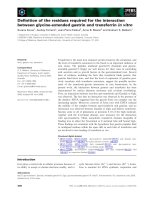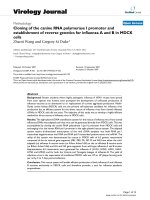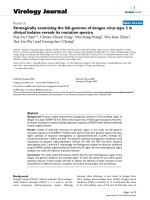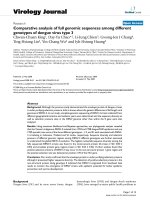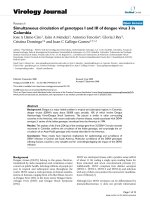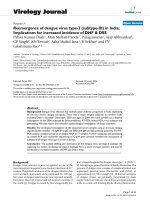MECHANISTIC CHARACTERISATION OF DENGUE VIRUS RNA DEPENDENT RNA POLYMERASE NON NUCLEOSIDE INHIBITOR BINDING POCKET THROUGH IN VITRO BIOCHEMICAL ASSAYS AND REVERSE GENETICS ANALYSES
Bạn đang xem bản rút gọn của tài liệu. Xem và tải ngay bản đầy đủ của tài liệu tại đây (2.62 MB, 132 trang )
MECHANISTIC CHARACTERIZATION OF DENGUE VIRUS
RNA DEPENDENT RNA POLYMERASE NON-NUCLEOSIDE
INHIBITOR BINDING POCKET THROUGH IN VITRO
BIOCHEMICAL ASSAYS AND REVERSE GENETICS
ANALYSES
Dorcas Adobea Larbi
NATIONAL UNIVERSITY OF SINGAPORE
2012
MECHANISTIC CHARACTERIZATION OF DENGUE VIRUS
RNA DEPENDENT RNA POLYMERASE NON-NUCLEOSIDE
INHIBITOR BINDING POCKET THROUGH IN VITRO
BIOCHEMICAL ASSAYS AND REVERSE GENETICS
ANALYSES
Dorcas Adobea Larbi
B.Sc. (Hons.), University of Cape Coast
A THESIS SUBMITTED
FOR THE DEGREE OF MASTER OF SCIENCE IN
INFECTIOUS DISEASES, VACCINOLOGY AND
DRUG DISCOVERY
DEPARTMENT OF MICROBIOLOGY
NATIONAL UNIVERSITY OF SINGAPORE
2012
DECLARATION
I hereby declare that the thesis entitled "Mechanistic Characterization of
Dengue Virus RNA Dependent RNA Polymerase Non-Nucleoside
Inhibitor Binding Pocket through In Vitro Biochemical Assays and
Reverse Genetics Analyses" is my original work and it has been written
by me in its entirety. I have duly acknowledged all the sources of
information which have been used in the thesis.
This thesis has also not been submitted for any degree in any university
previously.
Dorcas Adobea Larbi
27 November 2012
i
ACKNOWLEDGEMENTS
My sincere gratitude is expressed towards Dr. Shi, Pei-Yong of
Novartis Institute for Tropical Diseases, NITD and National University
of Singapore, NUS for his innovative ideas and encouragement during
this research work. I am forever indebted to my supervisor Dr. Lim,
Siew Pheng of NITD, whom I closely worked with for the success of
this research. Dr. Lim, I really value your concern, support and
attention to details in this work at all times. Your indispensable
directions,
expertise,
meticulousness
and
ground-breaking
encouraging ideas really inspired me and have undoubtedly led to the
success of this study. Again, I would like to express my gratitude to
Prof. Pascal Mäser of Swiss Tropical and Public Health Institute (Swiss
TPH), Switzerland for accepting to co-supervise my research study. His
support and tutoring most especially during our studies in Basel cannot
be underestimated.
I am most grateful the Swiss TPH for funding my studies and
NITD for enabling me to use their facilities for my research study.
Special thanks to coordinators of this programme most especially Prof.
Marcel Tanner of Swiss TPH and Prof. Markus Wenk of National
University of Singapore (NUS) and also to our two ladies; Ms. Christine
Mensch and Ms. Susie Soh for contributing to the success of our
studies in Basel and Singapore. My appreciation as well goes to all our
tutors for generously sharing their knowledge with us and also, making
time to answer all the questions we asked during lectures.
ii
Special thanks goes to Seh, Cheah Chen; Chung, Ka Yan and
Ghafar, Nahdiyah for providing me the time, brilliant ideas and
assistance whenever I approached them. Their work and dedication to
this study is very much appreciated. Not forgetting my Disease Biology
friends including: Xie, Xuping, Dong, Hongping, Yip, Andy; Zou, Jing;
Vasudevan, Dileep; Susila, Agatha; Lee, Le Tian; Chang, David; Chew,
Kelly; Chao, Alex and Yeo, Kim Long for their friendship and
willingness to share their knowledge with me.
I would like to express my profound thanks and love to my
wonderful Husband, Patrick Kwasi Otoo who is always there for me
and whose love, care, companionship and motivation propelled me to
have a smooth sail in my MSc studies. My family is also not left out
knowing that they have been of great asset to me. Thank you so much.
I also do acknowledge my friends and course mates for spicing my
social life both in Basel and Singapore. Finally, I would like to express
my sincere thanks to the Almighty God in heaven whose blessings,
favour, strength and grace has been with me and has granted me the
opportunity to begin this interesting research paving way to my career
in drug discovery.
iii
TABLE OF CONTENTS
DECLARATION……………………………………………………….. i
ACKNOWLEDGEMENTS ............................................................
ii
TABLE OF CONTENTS.................................................................. iv
SUMMARY....................................................................................
ix
LIST OF TABLES............................................................................ xi
LIST OF FIGURES ....................................................................... xii
ABBREVIATIONS.......................................................................... xiv
CHAPTER 1: LITERATURE REVIEW........................................... 1
1.1
Evolution of Dengue Virus................................................. 1
1.2
Divergence from Non-infectious to an
Infectious Pathogen............................................................ 2
1.3
DENV Epidemiology and Global Consequence.............. 4
1.4
Dengue Virus Pathogenesis and Host Immune
Response............................................................................ 6
1.4.1 Host Immune Response.......................................... 6
1.4.2 Dengue Virus Pathogenesis................................... 7
1.4.3 Antibody Induced Enhancement of Dengue
Virus.......................................................................... 7
1.5
Clinical Signs and Symptom............................................. 9
1.6
Life Cycle of Dengue Virus............................................... 10
1.7
Virus Morphology ............................................................ 13
1.8
Dengue virus genome....................................................... 15
1.9
Virus Structural Proteins .................................................. 17
iv
1.9.1 Capsid Protein.......................................................... 17
1.9.2 Membrane Protein ................................................... 18
1.9.3 Glycoprotein Envelope ............................................ 18
1.10
Virus Non-structural Proteins............................................ 19
1.10.1 NS1........................................................................... 19
1.10.2 NS2A......................................................................... 20
1.10.3 NS2B......................................................................... 20
1.10.4 NS3............................................................................ 21
1.10.5 NS4A........................................................................ 22
1.10.6 NS4B......................................................................... 22
1.10.7 NS5............................................................................ 23
1.10.7.1
Role of NS5 in DENV Pathogenesis........ 24
1.10.7.2
NS5 Methyltransferase .......................... 25
1.10.7.3
NS5 RNA-dependent RNA Polymerase.... 26
1.10.7.4
Structure of NS5 RNA-dependent
RNA Polymerase...................................... 27
1.11 Rationale ................................................................................. 31
1.11.1 Objectives of Study.................................................... 33
CHAPTER 2: MATERIALS AND METHODS.................................. 34
2.1
Cloning of pET28a-D4MY01-NS5-22713 NS5
Mutants using Site-directed Mutagenesis........................... 34
2.2
Expression and Purification of DENV 4 FL
NS5 Mutant Protein Histidine-tagged.................................. 36
2.2.1 Expression of DENV 4 FL NS5................................... 36
2.2.2 Purification of DENV 4 FL NS5 mutant protein ....... 37
v
2.3
In-vitro Transcription of pUC19-D4-5´UTR-L-3´UTR
Plasmid .............................................................................. 38
2.4
Cell-Free Assay................................................................... 39
2.4.1 Biochemical Enzymatic Assays ........................................ 39
2.4.1.1
FAPA De novo Initiation ............................. 41
2.4.1.2
FAPA Elongation Assay ............................. 41
2.4.2 Differential Scanning Fluorimetry
(Thermofluorescence Assay)............................................ 44
2.4.3 Measurement of Steady-state Kinetic Parameters.......... 44
2.4.3.1
RNA Km Studies in De novo Assay............. 45
2.4.3.2
NTP Km Studies in De novo Assay.............. 46
2.5
Cloning of DENV 2 TSV01-F subclone mutants............... 46
2.6
Cloning of DENV 2 TSV01-F Subclone
K402A Mutant using Overlapping PCR............................ 48
2.7
Construction of Recombinant Plasmids........................... 50
2.8
Ligation of DENV 2 pACYC-FL TSV01 with
TSV01-F Subclone mutants............................................... 51
2.9
Production of Recombinant Viruses................................ 53
2.9.1 Linearization of Plasmid ....................................... 53
2.9.2 In-vitro Transcription of DENV 2 FL
pACYC-FL TSV01……………………………………... 54
2.10
Cell Culture and Cell Lines................................................. 54
2.11
Media for Cell Biological Studies........................................ 55
2.12
Growing and Maintaining of Cell Lines.............................. 56
2.13
RNA Transfection of Cells................................................... 58
vi
2.14
Cell-Based Assay ............................................................... 59
2.14.1 Indirect Immunofluorescence Assay....................... 59
2.14.2 Plaque Assay.............................................................. 61
CHAPTER 3: RESULTS................................................................... 63
3.1
Site-directed Mutagenesis.................................................. 63
3.2
Expression and Purification of DENV 4 FL NS5
Mutant Proteins................................................................... 63
3.3
In-vitro transcription of RNA using DENV 4 Template..... 67
3.4
Background of Biochemical Enzymatic Assays............... 68
3.4.1 FAPA De novo Initiation ................................................... 70
3.4.2 FAPA Elongation Assay .................................................... 71
3.5
Differential Scanning Fluorimetry........................................ 74
3.6
Measurement of Steady-state Kinetic Parameters............ 76
3.6.1 RNA Km Studies.......................................................... 77
3.6.2 NTP Km Studies........................................................... 78
3.7
Production of Recombinant Viruses................................... 79
3.7.1 Indirect Immunofluorescence Assay ....................... 80
3.7.2 Plaque Assay.............................................................. 83
CHAPTER 4: DISCUSSION AND CONCLUSION........................... 84
4.1
DENV 4 NS5 RdRp Characterization for In vitro
Polymerase Activity............................................................
85
4.1.1 Effects of Mutations on NS5 RdRp De novo
Initiation and Elongation Activities................................... 86
4.1.1.1
F399A and K402A................................. 88
vii
4.1.1.2
F486A and N493A................................. 88
4.1.1.3
G605A, Y607A, and N610A ................... 89
4.1.1.4
D664A...................................................... 90
4.1.1.5
W796A.................................................... 92
4.1.2 Stability of DENV NS5 RdRp mutants ................... 93
4.1.3 Effects of NTP Km and RNA Km on DENV FL
NS5 Mutants.............................................................. 94
4.2
Characterization of DENV 2 TSV01 NS5 Mutants............ 95
4.2.1 Expression of Viral Proteins and RNA ................... 96
4.2.2 Plaque Morphology.................................................. 98
4.3
Summary of Discussion ................................................... 99
4.4
Conclusion ........................................................................ 101
BIBLIOGRAPHY.............................................................................. 102
viii
SUMMARY
Dengue virus (DENV) is among the most important human
arboviral pathogens. The virus infects about 50 million people
worldwide leading to broad spectrum of outcome from a mild febrile
illness to fatal haemorrhage and shock syndrome (Endy et al., 2010)
and there are currently no clinically approved vaccines or antivirals for
this disease. DENV has three structural and seven non-structural
proteins (NS). NS5 has RNA-dependent RNA polymerase (RdRp)
activity which plays a major role in viral replication and has also been
associated with disease pathogenesis. DENV RdRp domain has been
identified by X-ray crystallography to bind several non-nucleoside
inhibitors. Thus, this research study was to assess the drug-ability and
relevance of the RdRp binding pocket of two non-nucleoside inhibitor
compounds from Novartis Institute for Tropical Diseases (NITD) that
binds to the catalytic domain of the enzyme.
Experiments were done to investigate the importance of the
inhibitor binding pocket for in vitro polymerase activity and as well for
replication fitness in context of the DENV 2 TSV01 infectious virus. For
these studies, individual amino acids lining this pocket that interacted
with the inhibitors were mutated to alanine. Biochemical enzymatic
assays were used to measure the ability of the RdRp proteins to carry
out de novo initiation and elongation activities. Results obtained
showed decreased enzymatic activities for full length (FL) NS5 F399A,
K402A, F486A, N493A, Y607A, N610A and D664A proteins whilst
G605A and W796A proteins displayed an increase in de novo initiation
ix
activity but with no distinct change in elongation activity compared to
the wild-type (WT) protein.
The exception was Y607A which demonstrated significant
increase in RdRp elongation activity whilst G605A also showed a slight
decrease in activity. K402 residue showed to be required for both de
novo initiation and elongation process whilst Y607 was determined to
play an essential role in polymerase activity only during de novo
initiation of viral RNA synthesis. Residues F486 and G605 generally
demonstrated no effect in both de novo initiation and elongation steps
of RNA replication suggesting that these residues are not crucial for
RdRp enzyme activity.
Similarly, engineering of five mutated residues into genomic
RNA of infectious clone for viral infection studies showed that residues
F399, N493, N610 and D664 are critical for viral replication. These
residues have also demonstrated a significant role in functioning both
at the step of de novo initiation and elongation during the synthesis of
RNA. W796A exhibited ~50% decrease in IFA positive cells and was
able to recover less than 25% of virus titres as compared to WT which
was in contrast to its remarkable performance during in vitro enzyme
activity studies. This work contributes to understanding the biological
function of residues lining the RdRp catalytic domain in DENV NS5.
Gaining insight into specific active site residues is essential for the
development of anti-viral inhibitors.
x
LIST OF TABLES
Table 1.1
Interaction of DENV NS5 RdRp amino acid residues
with NITD567and NITD329 Compounds.................. 32
Table 1.2
IC50 results from NITD567 and NITD329................. 33
Table 2.1
DENV 4 Mutants Primers for Site-specific Mutation in
pET28a-D4MY01-NS5-22713 Template Plasmid...... 35
Table 2.2
Summary of Standard Assay Condition for FAPA
De novo Initiation and Elongation............................ 43
Table 2.3
DENV 2 Mutant Primers for Site-specific Mutation in
TSV01-F Subclone Template Plasmid ..................... 47
Table 2.4
DENV 2 Primer for Site-specific Mutation in TSV01-F
Subclone Plasmid by Overlapping PCR.................... 48
Table 2.5
DENV 2 TSV01 primers used for PCR ...................... 53
Table 2.6
Primary antibodies and their working dilutions........60
Table 2.7
Secondary antibodies and their working
dilutions........................................................................ 60
Table 3.1
DENV 4 FL NS5 Mutant Protein Yield ...................... 67
Table 3.2
Categories of Change in Denv 4 NS5 FL Mutant
Proteins Enzymatic Activities as Compared
to WT............................................................................ 72
Table 3.3
RdRp Enzyme Activity of DENV 4 FL NS5
Mutants .....................................................................
Table 4.1
73
Summary of mutagenesis analysis of nine NS5
RdRp mutants.............................................................100
xi
LIST OF FIGURES
Figure 1.1 Phylogenetic tree of DENV serotypes ..................... 3
Figure 1.2 World map showing countries and areas where
dengue viral infection has been reported or at
risk of dengue pandemic ........................................... 5
Figure 1.3 Schematic representation of dengue virus
life cycle in host cell................................................. 11
Figure 1.4
Structure of matured E protein on viral
particle surface.......................................................... 14
Figure 1.5
Schematic diagram of Dengue virus genome........ 16
Figure 1.6
Simplified diagram of DENV RNA genome
indicating NS5 RdRp region.................................... 24
Figure 1.7
Ribbon structure of the closed conformation
of DENV 3 NS5 RdRp................................................ 28
Figure 1.8
DENV 1 to 4 NS5 RdRp construct sequence
alignment................................................................... 30
Figure 3.1
Protein expression and purification profile of
DENV 4 NS5 FL......................................................... 65
Figure 3.2
Purification profile of DENV 4 FL NS5 ................... 66
Figure 3.3
Purified proteins of DENV 4 FL NS5....................... 67
FIgure 3.4
In vitro transcription of plasmid
pUC19-D4-5'UTR-L-3'UTR....................................... 68
Figure 3.5
Schematic diagram showing principle for
measuring NS5 RdRp activity
xii
.............................. 69
Figure 3.6
Simplified structure of Denv 4 5’UTR-3’UTR RNA
template used in FAPA de novo initiation assay......70
Figure 3.7
Structure of 3’UTR-U30 RNA primer template for
FAPA elongation assay............................................. 72
Figure 3.8
Thermofluorescence assay results......................... 75
Figure 3.9
Steady-state Kinetic Parameters: RNA Km ............. 77
Figure 3.10 Steady-state Kinetic Parameters: NTP Km .............. 78
Figure 3.11 Cloning of pACYC-FL TSV01 and viral
IVT RNA production.................................................... 80
Figure 3.12 Effects of mutagenesis on viral replication of
DENV 2 pACYC TSV01 infectious clone................... 82
Figure 4.1
Schematic representation of DENV RdRp de novo
RNA synthesis............................................................ 87
Figure 4.2
Ribbon diagram showing the conserved motifs in
RdRp catalytic domain............................................... 91
xiii
ABBREVIATIONS
aa
Amino acid
ADE
Antibody Dependent Enhancement
AMP
Ampicillin
APS
Ammonium Persulfate
BBT
2’-[2-benzothiazoyl]-6’hydroxybenzothiazole
BBT-ATP
BBT conjugated to Adenosine triphosphate
BBT-CTP
BBT conjugated to Cytidine triphosphate
BBTppi
BBT conjugated to diphosphate
BHK
Baby Hamster Kidney
BSA
Bovine Serum Albumin
BVDV
Bovine Viral Diarrhea Virus
C
Capsid Protein
CHAPS
3-[(3-cholamidopropyl)dimethylammonio]-1-propanesulfonate
CIP
Calf Intestinal Alkaline Phosphatase
CS
Cyclization Sequence
DC
Dendritic Cell
DEA
Deoxyethanolamine
DENV
Dengue Virus
DF
Dengue Fever
DHF
Dengue Hemorrhagic Fever
DNA
Deoxyribonucleic Acid
DSS
Dengue Shock Syndrome
E
Envelope protein
Emissionmax
Maximum Emission
Excitationmax
Maximum Excitation
Fluorescence-based Alkaline Phosphatase coupled
FAPA
polymerase Assay
FBS
Fetal Bovine Serum
FL
Full-Length
FPLC
Fast Protein Liquid Chromatography
His-tag
Histidine tagged
xiv
hr
hour
ID
Identity
IFA
Immunofluorescence Assay
IFN
Interferon
IgG
Immunoglobulin G
IgM
Immunoglobulin M
IL
Interleukin
IPTG
Isopropyl-β-D-thiogalactopyranoside
JEV
Japanese Encephalitis Virus
Kan
Kanamycin
Kb
Kilobases
kcat
“Turnover” number
kD
Kilodaltons
Km
Michaelis-Menten constant
LB
Luria-Bertani
Min
Minutes
mRNA
Messenger Ribonucleic acid
MTase
S-adenosyl-methionine transferase
NaCl
Sodium Chloride
NC
Nucleocapsid
Ni
2+
His-Trap HP
NiNTA
Nickel Nitrilotricacetic Acid
NITD
Novartis Institute of Tropical Disease
NLS
Nuclear Localization Sequence
NS
Non-structural protein
NTP
Nucleoside triphosphate
O/N
Overnight
ORF
Open Reading Frame
PBS
Phosphate Buffered Saline
PCR
Polymerase Chain Reaction
pfu
Plaque Forming Unit
prM
Membrane protein precursor
RdRp
RNA-dependent RNA polymerase
xv
RFU
Relative Fluorescence Unit
RNA
Ribonucleic Acid
rpm
Revolutions Per Minute
RT
Room Temperature
SDM
Site-Directed Mutagenesis
SDS-PAGE
Sodium dodecyl sulphate polyacrylamide gel
Tm
Mid-point temperature of protein unfolding transition
Tris-HCl
Tris-Hydrochloric Acid
UTR
Untranslated region
Vmax
Maximal velocity
vRNA
Viral RNA
WHO
World Health Organization
WNV
West-Nile Virus
WT
Wild-type
YFV
Yellow Fever Virus
xvi
Literature review
CHAPTER 1
LITERATURE REVIEW
1.1
Evolution of Dengue Virus
Dengue viruses (DENV) are the most important human
arboviral pathogens. Transmission of the virus in tropical and
subtropical regions of the world includes sylvatic or enzootic cycle
between nonhuman primates and mosquito vectors such as Aedes
furcifer, Aedes luteocephalus, Aedes taylori as well as an urban
endemic or epidemic cycle principally between Aedes aegypti vector
and humans (Cardosa et al., 2009). DENV evolutionary path differs in
several aspects from its Flavivirus cousins, though it retains many of
the same clinical characteristics as severe fever (Bennett, 2010).
Studies have shown that dengue virus like some other
flaviviruses, was previously an enzootic indicating that its major
transmission in humans were likely to have evolved from non-human
primates about 100 to 1500 years ago to a sustained human
transmission (Wang et al. 2000). Thus DENV infection in humans might
have been incidental but have since established themselves as four
distinct serotypes (DENV 1, DENV 2, DENV 3 and DENV 4) during the
last century resulting in periodic epidemics and severe disease (Wang
et al. 2000; Cardosa et al., 2009). The contemporary genetic diversity
seen in all four dengue serotypes could as well be attributed to the
continuous increase in population density and mass transport of both
virus and its mosquito vector.
1
Literature review
1.2
Divergence from Non-infectious to an Infectious Pathogen
Within each serotype, DENV are organized by genotypes,
subtypes, clades, variants, groups and finally strains (Figure 1.1). A
phylogenetic study of different dengue viruses has led to the
association between specific genotypes (within serotypes) and the
presentation of more or less severe disease. It has been suggested
that the immune status and possibly the genetic background of the
human host are also determinants of virulence or disease presentation
(Rico-Hesse, 2003). Whereby, specific viral structures may contribute
to increased replication in host target cells and to an increased
transmission by the mosquito vector.
The comparison of nucleotide sequences from the envelope (E)
and non-structural protein 1 (NS1) gene region of dengue virus
genome has shown to reflect evolutionary relationships and geographic
origins of the viral strains. This approach was used to demonstrate an
association between the introduction of two distinct genotypes of
dengue type 2 virus and the appearance of dengue hemorrhagic fever
in the Americans (Rico-Hesse et al., 1997). Combinations of the
dengue viral strains makes concurrent (multi-strain) infections or
reoccurring dengue infections possible, especially in areas with high
prevalence of dengue virus. In such cases, competitive strain
displacement occurs when a more virulent strain of the virus competes
with a less virulent strain, resulting in an alteration in strain frequency.
Thus, the more virulent strain can replicate and disseminate faster in
the vector and host decreasing the extrinsic incubation period.
2
Literature review
Figure 1.1:
Phylogenetic tree of DENV serotypes
The evolutionary tree of the different serotypes of dengue virus was derived from E
protein gene nucleotide sequences of sylvatic and endemic or epidemic DENV strains
(Wang et al. 2000).
3
Literature review
Phylogenetic and epidemiological analyses suggest that more
virulent genotypes are now displacing those that have lower
epidemiological impact (Wang et al. 2000; Cologna et al., 2005). Some
genotypes Southeast Asia and India have been associated with the risk
of causing severe dengue hemorrhagic fever (DHF) and dengue shock
syndrome (DSS) (Rico-Hesse, 2003). In view of that, understanding the
virulence and attenuation of the virus is key for development of
vaccines and antiviral agents.
1.3
DENV Epidemiology and Global Consequence
Dengue epidemics can have a significant economic and health
toll as it plays a leading role in public health threat in the tropical and
subtropical regions (Wilder-Smith et al., 2010). According to WHO, the
global incidence of dengue has increased dramatically to about 30-fold
over the past 50 years and about 2.5 billion people forming 40% of the
world´s population are now at risk of the disease (Figure 1.2). Each
year, WHO estimates about 50-100 million DENV infections worldwide.
Approximately, 500,000 people with severe dengue are hospitalized
annually, of whom 2.5% die (WHO, 2012).
Increase in dengue viral infection, pandemic and severity, may
largely be attributed to factors such as increased urbanization and
population density, inadequate housing and public health systems,
poor vector control, climate change, viral evolution and increased
4
Literature review
international travel to endemic areas. This has led to the geographic
spread, evolution, overlap and interaction of all four dengue viral
serotypes (Endy et al., 2010).
Risk of dengue infection
Areas with no known infection
Figure 1.2: World map showing countries and areas where dengue viral infection has
been reported or at risk of dengue pandemic (World Health Organization, 2012)
Spatial and temporal patterns of dengue prevalence are likely
driven by other factors including the immune status of human hosts,
their age, virus traits, and environmental variables including aspects of
climate such as levels of precipitation (Rico-Hesse et al., 1997).
5
Literature review
1.4
Dengue Virus Pathogenesis and Host Immune Response
1.4.1 Host Immune Response
During dengue viral infection, natural killer (NK) cells and
dendritic cells (DCs) of the innate system are able to detect and induce
the release of antiviral cytokines to control viral replication (Trinchieri,
1989). DCs detect and displays processed peptides of the invading
pathogen for recognition by T cells of the adaptive immune system
(Lindahl et al., 1976; Schroder et al., 2004; Welsh et al., 2012).
Activated CD4+ T helper cells secrets antiviral cytokines that also
activates the immune components to fight the infection whilst activated
CD8+ T cytotoxic cells also recognize and kill DENV infected cells
(Lindahl et al., 1976; Schroder et al., 2004; Welsh et al., 2012). B cells
on the other hand produces antibodies (Abs) against DENV, some of
which play critical roles in neutralizing homologous DENV against reinfection.
Activation of the complement system through the mannose
binding lectin pathway triggers several events which reduced DENV
infection (Shresta, 2012). The release of antiviral cytokines such as
type 1 interferon (IFNs) plays a critical role to limit spread of infection
(Schroder et al., 2004). The role of IFN includes up regulating the
expression of class I and II major histocompactibility complex (MHC)
thereby activating the function of T helper cells (Lindahl et al., 1976;
Schroder et al., 2004; Welsh et al., 2012).
6
Literature review
1.4.2 Dengue Virus Pathogenesis
To successfully survive in the host, flaviviruses such as
DENV has been shown to inhibit some important innate immune
elements like type 1 IFN signaling and in the phosphorylation of some
kinases (Jones et al., 2005; Ho et al., 2005). DENV NS5, NS2A, NS4A
and NS4B proteins have been found to serve as antagonist for type 1
IFNs (Munoz-Jordan et al., 2003, 2005; Liu et al., 2004; Ashour et al.,
2009) with NS5 serving as the most potent inhibitor of IFN signaling by
targeting and degrading several components of the signaling pathway
such as STAT2 (Ashour et al., 2009).
Studies have shown that inhibition of IFN signaling by NS5
occurs in a species specific manner due to the inability of NS5 to bind
and degrade STAT2 in mice, resulting in limited host tropism of DENV
to humans and non-human primates (Ashour et al., 2009; Perry et al.,
2011). NS5 also induces cytokine production such as interleukin 8 (IL8) transcription and secretion resulting in the recruitment of several Fc
receptor bearing cells to the infection site thereby enhancing the
spread of the virus due to its special ability to infect neighboring cells
(Medin et al., 2005).
1.4.3 Antibody Induced Enhancement of Dengue Virus
The mechanism in which DENV successfully survive in the host
cell resulting in severe complications is not completely resolved.
Structural differences in DENV strains have been proposed to play a
7
